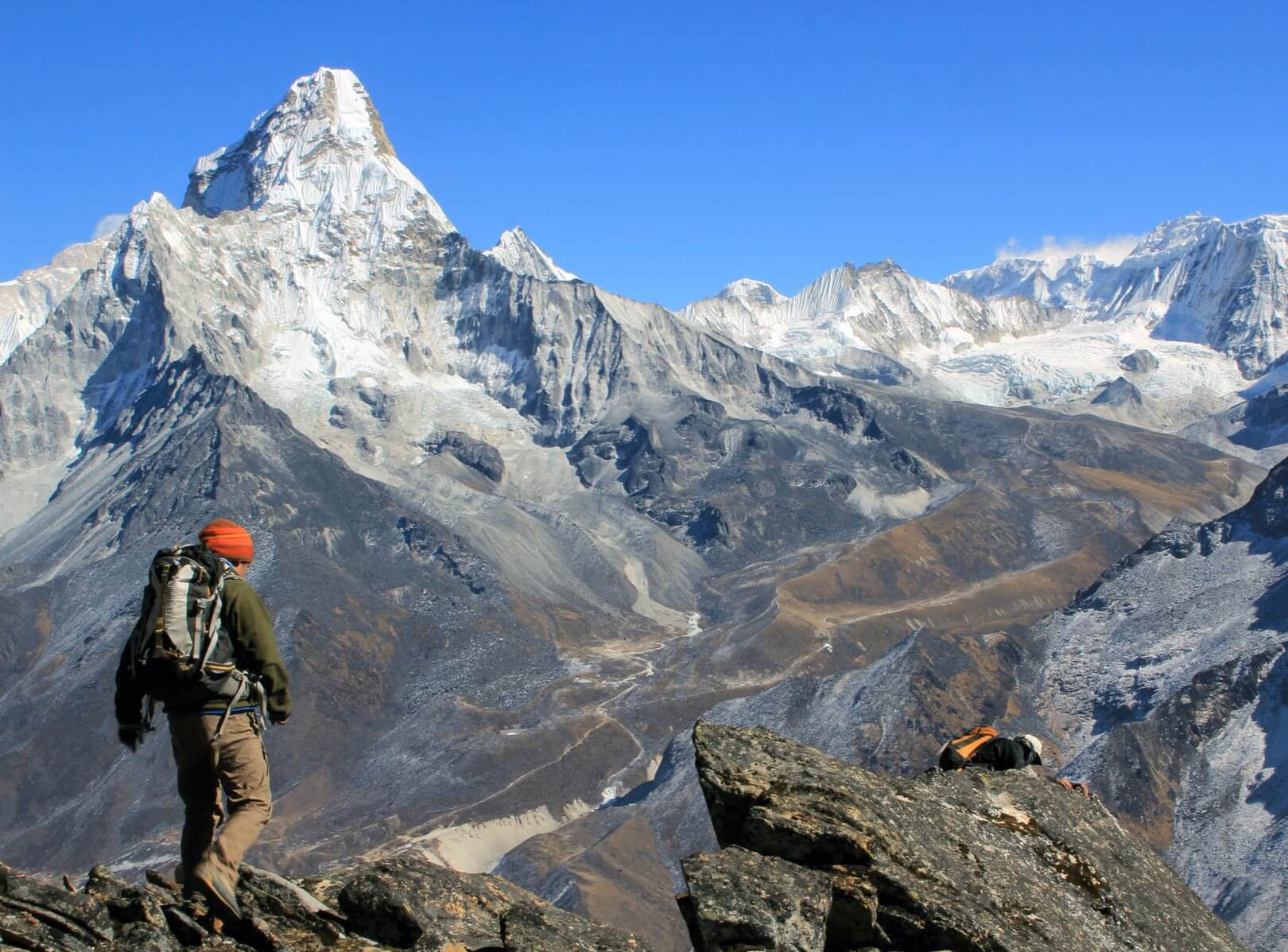
Mardi Himal Trek 8 Days Itinerary and Cost
Tour Gallery
Overview
Mardi Himal Trek
Nepal, renowned for its majestic peaks and breathtaking landscapes, is a haven for trekking enthusiasts seeking an immersive mountain experience. The Mardi Himal Trek stands as a hidden gem among the myriad trek options, offering a unique blend of tranquility, panoramic views, and cultural encounters.
This article delves into the intricacies of the Mardi Himal Trek, exploring its route, highlights, challenges, and enchanting stories it weaves.
Introduction to Mardi Himal Trek
Situated in the Annapurna region, the Mardi Himal Trek is a relatively off-the-beaten-path adventure that leads trekkers to the base of Mardi Himal, a lesser-known yet captivating peak. The journey is marked by diverse terrain, from lush rhododendron forests to high alpine landscapes, providing a rich tapestry of natural wonders.
The Itinerary
The trek typically starts and ends in Pokhara, the picturesque lakeside city in central Nepal. The itinerary spans approximately 10 days, allowing trekkers to immerse themselves in the unparalleled beauty of the Himalayas. Highlights include Forest Camp, High Camp, and the Mardi Himal Base Camp, each offering distinct vistas and experiences.
Route Highlights
Australian Camp and Landruk:
The trek starts with a scenic drive from Pokhara to Kande, followed by a trek to Australian Camp. The trail winds through charming Gurung villages like Landruk, providing a glimpse into the local culture.
Rhododendron Forests
As trekkers ascend, the trail takes them through enchanting rhododendron forests, ablaze with vibrant blooms during the spring season. The diversity of flora adds a kaleidoscopic touch to the journey.
High Camp and Mardi Himal Base Camp:
High Camp serves as a gateway to the Mardi Himal Base Camp. The trek to the base camp unfolds unparalleled views of Mardi Himal, Machhapuchhre, Annapurna South, and Hiunchuli, creating a panorama that lingers in memory.
Siding Village:
The descent from High Camp leads to the serene Siding Village, offering a tranquil interlude amidst terraced fields and welcoming local hospitality.
Challenges and Considerations
While the Mardi Himal Trek is generally considered moderate, trekkers should be prepared for varying weather conditions, especially during winter. Adequate acclimatization is essential, and a reasonable level of physical fitness is recommended to navigate the trail’s ascents and descents.
Cultural Encounters
The Mardi Himal Trek provides opportunities for cultural immersion, particularly in Gurung and Magar villages along the route. Trekkers can interact with locals, partake in traditional rituals, and savor local cuisine, adding a cultural dimension to the mountain adventure.
Best Time to Trek Mardi Himal
The ideal times to undertake the Mardi Himal Trek are during the pre-monsoon (spring) season from March to May and the post-monsoon (autumn) season from September to November. These periods offer stable weather conditions and clear mountain views.
Why Choose Mardi Himal Trek?
Less Crowded:
Compared to more popular treks, Mardi Himal sees fewer trekkers, providing a quieter and more intimate experience with nature.
Unspoiled Landscapes:
The route takes trekkers through pristine landscapes, allowing for a genuine connection with the unspoiled beauty of the Himalayas.
Panoramic Views:
Mardi Himal Base Camp offers stunning panoramic views of iconic peaks, making it a photographer’s paradise.
Cultural Richness:
Interactions with local communities provide a genuine cultural experience, offering insights into the traditions and lifestyles of the Gurung and Magar people.
Conclusion
In conclusion, the Mardi Himal Trek emerges as a hidden jewel in Nepal’s trekking crown. Beyond the famed trails lies a route that beckons with the promise of uncharted beauty, cultural revelations, and the awe-inspiring presence of the Himalayas.
For those seeking a trek that balances tranquility with adventure, the Mardi Himal Trek is an invitation to explore the lesser-known wonders of the Annapurna region. This journey leaves an indelible mark on the hearts of those who venture into its hidden splendor.
Trip Highlights
- ☞Mardi Himal Trek is a teahouse trekking experience.
- ☞Basil Good fellow first climbed Mardi Himal in 1961.
- ☞Mardi Himal has very few trekkers, making the journey peaceful.
What's Included
Included Services
- ✓Airport pickup and drop services on a private vehicle
- ✓Transportation from Kathmandu to Pokhara in tourist bus both way (optional flight with extra costs)
- ✓Food all along the trip(Breakfast, Lunch, Dinner and a cup of coffee or tea) and accommodations during the trip in hotels with family environment(including one night stay in Pokhara)
- ✓Licensed English or Chinese or Korean or Hindi along with Nepali speaking trekking guide
- ✓Transportation, food, accommodation and insurance of Guide and/or Porter during the trip
- ✓Down jacket, all-season sleeping bag, duffel bag and trekking map(in case if you dont have your own. Down jacket, sleeping bag and duffel bag must be returned after completion of the trip)
- ✓First Aid Medical Kit(Carried by the guide)
- ✓All the required permits and paperworks
- ✓Welcome or farewell dinner in Kathmandu at a cultural restaurant(complimentary)
- ✓A nation-wide operated Mobile SIM Card and a map of the trekking region
- ✓Porter
- ✓Private Jeep,flight
Optional Addons
Excluded Services
- ✗International Airfare
- ✗Visa Charges
- ✗Hotel Expenses(In Kathmandu or in Pokhara after package ends)
- ✗Your travel and medical insurance
- ✗Personal Expenses such as shopping, bar bills, hot shower, telephone, laundry, titbits etc
- ✗Food and accommodations in Kathmandu
- ✗Emergency expenses such as expenses on charted helicoptor
- ✗Tips for guides and porters
Detailed Itinerary
More Information
How many days is the Mardi Himal trek?
The Mardi Himal trek typically spans 8 days, offering a well-paced journey through diverse landscapes, including rhododendron forests, high alpine meadows, and the captivating Mardi Himal Base Camp.
How do I get to Mardi Himal?
First, after meeting in Kathmandu, we will be grabbing a ride straight to Pokhara. From Pokhara, we will drive to Kande and have a short trek before we reach derail. Spending the night there, a few days of the trek will take us to Mardi Base Camp at an altitude of a whooping 4500 meters. After enjoying the moment, we continue our way back to Pokhara and then Kathmandu,
How much does the Mardi Himal trek cost?
The cost of the Mardi Himal trek varies based on factors such as the trekking agency, inclusions, and amenities. On average, the trek can range from $500 to $1,000, covering permits, guide and porter services, accommodation, and meals.
Which is better Annapurna Base Camp Trek or Mardi Himal trek?
The choice between the Annapurna Base Camp (ABC) Trek and the Mardi Himal Trek depends on personal preferences. The ABC Trek offers a more significant, established route with iconic views, while the Mardi Himal Trek is less crowded, providing a more tranquil experience with hidden gems.
Can you trek Mardi Himal without a guide?
Yes, it is possible to trek Mardi Himal without a guide. The trail is relatively well-marked, and the teahouse infrastructure is along the route. However, hiring a guide can enhance the experience by providing local insights, ensuring safety, and navigating unforeseen challenges.
What is the difficulty level of the Mardi trek?
The Mardi Himal trek is generally considered to be of moderate difficulty. While it doesn’t involve technical climbing, there are steep ascents and descents. Adequate acclimatization and a reasonable fitness level are crucial to navigating the terrain comfortably.
Is Mardi trek hard?
The Mardi Himal trek is not classified as brutal but falls into the moderate difficulty category. Trekkers should be prepared for varying weather conditions, including colder temperatures at higher elevations. With proper preparation and acclimatization, the trek is achievable for those with a reasonable fitness level.
Can I trek to Mardi Himal solo or do I need a guide?
Just 8 days of the trek, but the experience that comes with it is massive. Solo trekking on this site is definitely possible. But there’s much more to miss out on while trekking solo. We may even prepare a blog about what not to miss out on on the Mardi trek. But still, there would be something you miss out on. Thus, when with a guide, they make sure to squeeze out every drop of juice, to make this trek the best one.
Thus, it is highly recommended to hire a local guide. Additionally, hiring a guide will support the local economy and provide you with a more authentic trekking experience.
What kind of physical fitness is required for the Mardi Himal Trek?
The Mardi trek is moderate to the strenuous level of the trek. Although being just 8 days, it throws challenges all over the trail. Therefore, a good level of fitness is required to trek this site. You must be comfortable walking several hours a day with a backpack on. If you have any medical conditions, it is best to consult your doctor before embarking on the trek.
The cold temperature and extreme altitude may be problems that may later haunt you.
What kind of food is available during the Mardi Himal Trek?
The accommodation consists of typical teahouses and lodges. With it comes the typical traditional foods. It consists of dal bhat, noodles, pasta, and seasonal vegetables. Some teahouses may offer more variety, but it is best to be prepared for simple and basic meals. Whereas, some lodges also provide more variation of western food. But trying the traditional food itself is a great experience. Moreover, Nepali food is both tasty and nutritious at the same time.
What is the altitude gain during the Mardi Himal Trek and how does it affect trekkers?
When talking about the absolute peak, you reach an altitude of approx 4500 meters, the Mardi Base Camp. This will take you around 5-6 days of taxing walks. As you gain altitude, the air pressure and oxygen levels decrease, which can cause altitude sickness in some trekkers. Symptoms of altitude sickness include headache, nausea, fatigue, and shortness of breath. It is important to acclimatize properly by ascending slowly and taking rest days if necessary.
Moreover, consulting a doctor before trekking these sites may benefit you in the long run. As these remote areas are not that great when it comes to health care.
What are the permits required to do the Mardi Himal Trek?
To do the Mardi Himal Trek, you will need to obtain two permits: the Annapurna Conservation Area Permit (ACAP) and the Trekkers’ Information Management System (TIMS) card. The ACAP permit costs 3000 NPR (approximately 30 USD) and the TIMS card costs 2000 NPR for individuals and 1000 NPR for groups. These permits can be obtained in Kathmandu or Pokhara.
What are some of the highlights of the Mardi Himal Trek that I should look out for?
Some of the highlights of the Mardi Himal Trek include:
Stunning views of the Annapurna mountain range, including Machhapuchhre (Fishtail), Hiunchuli, and Annapurna South
Scenic rhododendron forests in bloom (in spring)
A visit to the charming Gurung village of Landruk
The opportunity to observe traditional Nepalese rural life and culture
The serene Mardi Himal Base Camp, surrounded by towering peaks
The diverse landscapes include forests, rivers, and high-altitude meadows.



